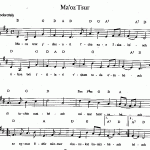A Ma’oz Tzur commentary
 The rhyme and rhythm of Ma’oz Tzur go together with the skilful interweaving of Biblical phrases and Midrashic allusions. So well has the poet done his work that we hardly notice that he has utilised pre-existing material.
The rhyme and rhythm of Ma’oz Tzur go together with the skilful interweaving of Biblical phrases and Midrashic allusions. So well has the poet done his work that we hardly notice that he has utilised pre-existing material.
This piece looks at a few interesting phrases.
Stanza 1 (Ma’oz Tzur):
L’et tachin matbe’ach (“When You prepare the slaughter of the blaspheming foe”) alludes to the defeat of Gog and Magog who will attempt to overcome Israel before the coming of the Messiah.
A subtle change was made to this phrase when British Chief Rabbi JH Hertz authorised an amendment in the Singer Siddur to make the phrase read l’et tash’bit matbe’ach, which was then translated “When thou shalt cause all slaughter to cease and the blaspheming foe”.
After some years – presumably reflecting post-Holocaust thinking – the original wording was restored.
Stanza 2 (Ra’ot sav’ah):
Malchut eglah (“The dominion of the calf”) is a poetic reference to Egypt: Jer. 46:20 calls Egypt eglah yefeh-fiyyah, “a very fair heifer” which a gadfly from the north will sting into flight.
Stanza 3 (D’vir kodsho):
D’vir kodsho (“His holy oracle”): a common liturgical phrase.
D’vir probably does not come from davar, “a word”, or mean “oracle” but is from another Semitic root which means “back”; the phrase therefore denotes, “hindmost chamber”, “innermost room” of the Temple – i.e. the Holy of Holies.
Stanza 4 (K’rot komat):
Because of the rhythm, the opening words of this verse are often sung K’rot komat b’rosh bikkesh but bikkesh belongs to the next phrase and there should be a pause after b’rosh.
The meaning is, “To cut down the tall cypress (Mordechai), was the desire of the Agagite (Haman) son of Hamm’data”.
Stanza 5 (Yevanim nik’b’tzu alai):
Yavan = Ionia, i.e. Greece. The original Yavan (Gen. 10:2), fourth son of Yefet, settled in Greece.
B’nei vinah, literally “men of understanding”, refers to the sages.
A rabbinic play on words reads v’chol banayich limmudei HaShem, “And all your children shall be learned of the Lord” (Isa. 54:13) as bonayich, “your men of understanding” (Ber. 64a).
Stanza 6 (Chasof z’ro’a kod’sh’cha):
Some see this verse as a later addition reflecting the medieval persecutions of Jews. Others think it was in the original text but was dropped because of censorship.
It is probably the only passage in the Jewish liturgy that explicitly refers to Christians. Admon, “The Red One”, is Rome; b’tzel tzalmon (translated in ArtScroll as “in the nethermost shadow”) probably means “in the shadow of the cross” (tzelem).
Ro’im shivah, “seven shepherds”, are champions who will overcome Israel’s persecutors (Micah 5:4). Shivah (“seven”) need not be taken literally; it means an adequate number.
For more expositions and insights on Chanukah by Rabbi Dr Raymond Apple, visit the OzTorah Chanukah page.



